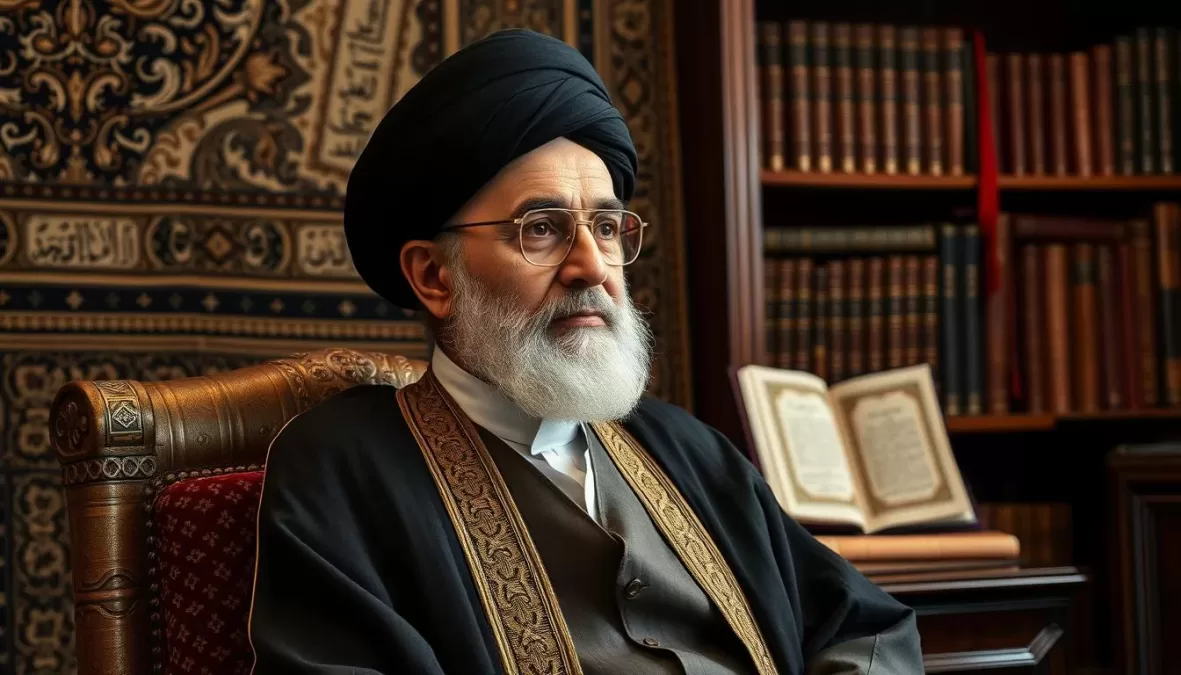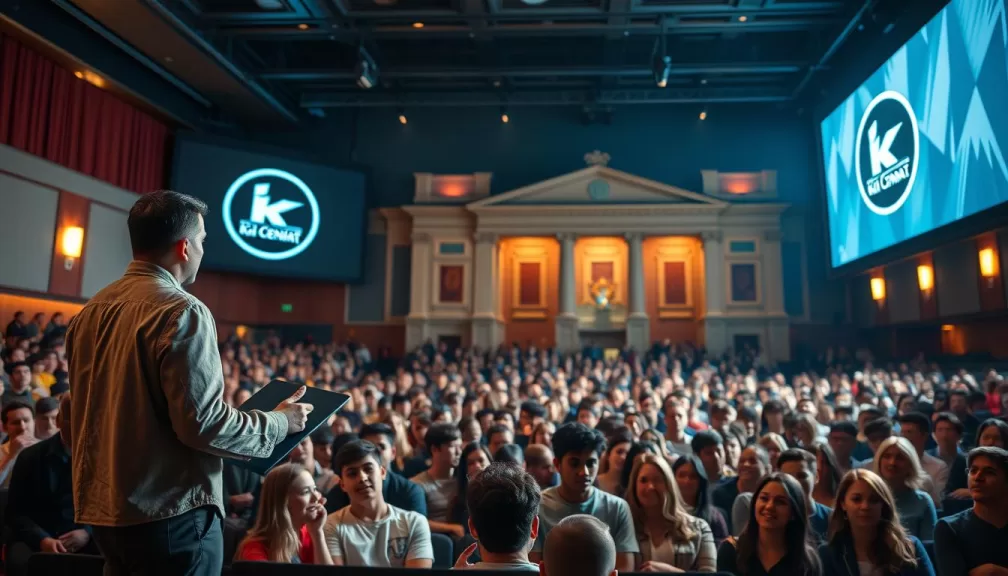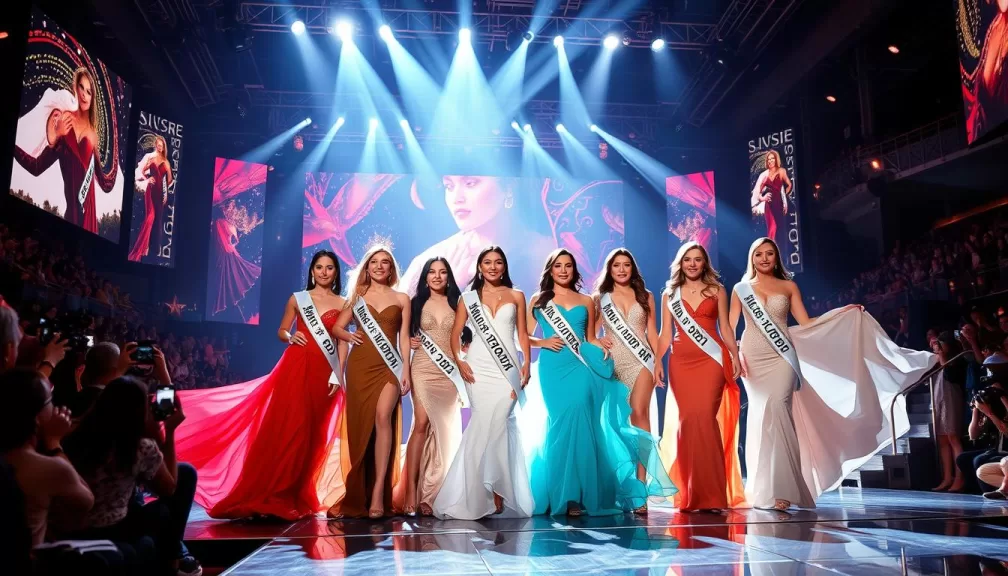Ali Khamenei was born on July 15, 1939, in Mashhad, Iran. He is a cleric and politician who has been Iran’s supreme leader since 1989. Before that, he was the country’s third president from 1981 to 1989.
Khamenei has ruled for 35 years, making him the longest-serving leader in the Middle East. He is also the second-longest-serving Iranian leader of the last century, after Shah Mohammad Reza Pahlavi. As a marja’, he is a top religious cleric in Twelver Shi’ism.
He played a crucial role in the Iranian Revolution. He was close to Ruhollah Khomeini and has held many government positions since the Islamic Republic was founded.
Key Takeaways
- Ali Khamenei has been the Supreme Leader of Iran since 1989.
- He previously served as the third President of Iran from 1981 to 1989.
- Khamenei is a highly influential figure in Iranian politics and the Islamic Revolution.
- He has faced various domestic challenges and protests during his tenure as Supreme Leader.
- Khamenei has played a significant role in Iran’s foreign policy, especially regarding the nuclear program and relations with the West.
Early Life and Background
Ayatollah Ali Khamenei was born on April 19, 1939, in Mashhad, a holy city. His family had a long history in the shia clerical lineage. This background helped shape his path as a key religious and political leader in Iran.
Mashhad Origins and Family History
Khamenei’s father, Sayyed Javad Khamenei, was a religious scholar known for his piety. The family lived in a simple, one-room house. Yet, Khamenei’s education was a top priority. He studied the Quran and Islamic teachings from a young age.
Humble Upbringing and Religious Education
Khamenei started at a traditional maktab, or primary-school, learning the Quran. He then moved to an Islamic school for more studies. At the theological seminary in Mashhad, he deepened his knowledge in Islamic jurisprudence.
“Khamenei’s humble upbringing and rigorous religious education laid the groundwork for his future as a prominent religious and political figure in Iran.”
Revolutionary Activism and Imprisonment
Ayatollah Ali Khamenei started fighting against the monarchy in the 1960s. He joined Ruhollah Khomeini’s followers, opposing the Shah’s pro-American and anti-Islamic policies. Khamenei’s strong support for an Islamic Republic in Iran led to many arrests by SAVAK.
Involvement in Iranian Revolution
Khamenei got involved in protests and anti-monarchy activities. As a religious scholar, he rallied support for the revolution. His khamenei role in iranian revolution was key to the 1979 success.
Arrests and Torture under Shah’s Regime
Khamenei’s anti-monarchy activities led to six arrests from 1963 to 1975. He faced political imprisonment and torture by savak. He was exiled for three years from 1976 to 1978 but kept fighting.
“Despite the persecution, Khamenei remained committed to the goal of overthrowing the Shah’s regime and establishing an Islamic Republic in Iran.”
Khamenei’s dedication to the revolution showed his strong will. He was willing to face imprisonment and torture for a better Iran.
supreme leader ayatollah ali khamenei bio
Ayatollah Ali Khamenei was born on April 19, 1939, in Mashhad, Iran. He has been the supreme leader of the Islamic Republic of Iran since 1989. His journey to power began with his role in the Iranian Revolution of 1979.
After the Iranian Revolution, Khamenei joined the Islamic Revolutionary Council. He became the deputy minister of defense and a leader of the Islamic Revolutionary Guards. He also led Friday prayers in Tehran, all under Ayatollah Khomeini’s guidance.
Khamenei’s career continued to grow. He was elected to the Iranian parliament in 1980. He then became the president of Iran for two terms, from 1981 to 1989.
When Khomeini passed away in 1989, Khamenei was chosen as the next supreme leader of Iran. He has held this position for over 30 years. His biography shows his strong dedication to the Iranian Revolution and his defense of Shia clerical authority.
“The Islamic Republic has emerged victorious from all the crises it has faced and will continue to do so in the future.”
– Ayatollah Ali Khamenei
Presidency (1981-1989)
Ayatollah Ali Khamenei was the President of Iran from 1981 to 1989. He was the first cleric to hold this office. Even though the president’s role was mostly ceremonial, Khamenei played a big part in the government. He built his power base, setting the stage for becoming the supreme leader later on.
Election as President and Reelection
Khamenei was first elected as President in 1981. He won again in 1985. His time as president, from 1981 to 1989, was crucial for Iran. It was a time of great change after the Islamic Revolution.
Tensions with Prime Minister Mousavi
Khamenei’s time as president was marked by disagreements with Prime Minister Mir Hossein Mousavi. The two leaders often argued over the government’s direction. Their political power struggles were a defining feature of that era.
| Key Highlights | Details |
|---|---|
| Election as President | Khamenei was elected as the President of Iran in 1981, becoming the first cleric to hold the office. |
| Reelection in 1985 | Khamenei was reelected as the President of Iran in 1985, further solidifying his political power. |
| Relationship with Mousavi | Khamenei’s relationship with Prime Minister Mir Hossein Mousavi was often tense and contentious, as the two leaders clashed over the direction of the government. |
Despite the power struggles, Khamenei remained a key figure in the new Islamic Republic. He built his influence and set the stage for becoming the supreme leader.

Succession as Supreme Leader
In 1989, Ayatollah Ali Khamenei became Iran’s supreme leader after Ayatollah Ruhollah Khomeini’s death. This move was controversial because Khamenei didn’t meet the usual qualifications. He wasn’t a senior cleric at the time.
The constitution was changed to let Khamenei take the top job. This change was made to help him become the supreme leader. The Assembly of Experts, a group of 88 senior clerics, chose him for this role.
The Assembly of Experts, elected in 2024, will serve until 2032. To become the next supreme leader, a candidate needs 59 votes. Ebrahim Raisi and Mojtaba Khamenei, the supreme leader’s son, are seen as top contenders.
| Potential Candidates for the Next Supreme Leader | Key Details |
|---|---|
| Hassan Rouhani | Former President of Iran |
| Mohsen Araki | Member of the Assembly of Experts |
| Alireza Arafi | Head of the Islamic Seminaries of Iran |
| Sadeq Larijani | Former Head of the Judiciary |
| Mohammad-Mahdi Mirbagheri | Member of the Assembly of Experts |
| Mojtaba Khamenei | Son of Supreme Leader Ali Khamenei |
| Hassan Khomeini | Grandson of Ayatollah Ruhollah Khomeini |
The next supreme leader’s choice will greatly affect Iran’s policies and its place in the world. As Iran faces many challenges, the world will watch this transition closely.
“The rules and procedures for political succession in Iran will be ignored and adjusted retroactively to legitimize the prevailing faction.”
Consolidation of Power
Ayatollah Ali Khamenei, as Iran’s Supreme Leader, has grown his power and influence. He made big changes through constitutional reforms in 1989. These changes let him control the government and society more.
Khamenei’s rule is marked by centralization of authority. He removed the prime minister and made the presidency stronger. This gave him more say in politics. The Guardian Council, picked by Khamenei, checks candidates for big offices. This tightens his grip on elections.
Khamenei’s reach goes beyond just politics. He controls the courts, military, and media too. This makes him the most powerful person in Iran. He decides what happens in the country.
“Khamenei’s consolidation of power has transformed the Iranian political landscape, empowering the Supreme Leader to shape the country’s trajectory with unprecedented influence.”

The constitutional changes and centralization of authority have changed Iran’s power balance. They’ve made Khamenei the clear ruler of the Islamic Republic.
Domestic Challenges and Protests
Ayatollah Ali Khamenei has faced many protests during his rule in Iran. From the 1994 Qazvin protests to the ongoing Mahsa Amini protests, Iran has seen many demonstrations. These have challenged Khamenei’s control over the country.
The 1999 student protests, the 2009 presidential election protests, the 2011-12 protests, and the 2017-18 protests were all met with a harsh crackdown. Journalists, bloggers, and dissidents have faced severe punishments for speaking out against Khamenei. This includes imprisonment, lashing, and long jail sentences.
Khamenei has responded to these protests under khamenei and civil unrest in iran by tightening his control. He has made constitutional changes to strengthen his power. He also relies on the Revolutionary Guards to crackdown on dissent and suppress opposition.
| Year | Protest | Outcome |
|---|---|---|
| 1994 | Qazvin protests | Suppressed by security forces |
| 1999 | Student protests | Violent crackdown, dozens killed |
| 2009 | Presidential election protests | Widespread arrests and detentions |
| 2011-12 | Protests against economic conditions | Brutal suppression by security forces |
| 2017-18 | Nationwide protests against economic issues | Dozens killed, thousands arrested |
| 2019-20 | Protests against fuel price hikes | Internet shutdown, hundreds killed |
| 2021-22 | Protests against water shortages | Ongoing crackdown by security forces |
| 2022-23 | Mahsa Amini protests | Ongoing, with widespread arrests and violence |
Despite Khamenei’s efforts to keep power, the Iranian people keep speaking out. This has led to a cycle of protests under khamenei, civil unrest in iran, and crackdown on dissent. The future of Iran’s stability is uncertain as Khamenei faces these challenges.
Foreign Policy and Nuclear Program
Ayatollah Ali Khamenei has been a key figure in Iran’s foreign policy and nuclear program. He has always stood against the West, refusing to make peace with the United States and other Western countries.
Fatwa Against Nuclear Weapons
In the mid-1990s, Khamenei issued a fatwa against nuclear weapons. This fatwa forbids the production, storage, and use of weapons of mass destruction. He made this fatwa public in October 2003 and confirmed it at an IAEA meeting in August 2005.
The fatwa was a response to Iran’s past, especially the Iran-Iraq war. During this time, 20,000 Iranians were killed and 100,000 were badly hurt. In 2021, Iran’s Minister of Intelligence said the fatwa could change if needed.
But Khamenei also supported breaking the 2015 nuclear deal, known as the JCPOA, after the US left it. He said entering the JCPOA was a way to hide Iran’s true intentions. This shows the complex nature of Iran’s nuclear policy under Khamenei.
Khamenei’s website says Iran follows Islamic tradition by not having nuclear weapons. He believes this is best for Iran’s security and future. In a speech after the JCPOA, Khamenei said Iran’s religious beliefs, not nuclear talks, stopped them from getting nuclear arms.
Relations with Presidents
Ayatollah Ali Khamenei has had different relationships with Iran’s presidents. He became the supreme leader in 1989. Since then, he has worked with several presidents, each with their own views and goals.
In the early 1990s, Khamenei got along well with conservative president Hashemi Rafsanjani. But, his relationship with reformist president Mohammad Khatami was tense. Khatami wanted to improve ties with the West, but Khamenei opposed this.
There was also a power struggle between Khamenei and conservative president Mahmoud Ahmadinejad. Khamenei was skeptical of moderate president Hassan Rouhani’s efforts to ease tensions with the West. Yet, he supported the 2015 nuclear deal.
Overall, Khamenei’s relationships with Iranian presidents show a balance of power and policy differences. This reflects his key role in Iran’s politics and foreign policy.
Human Rights Concerns
Ayatollah Ali Khamenei has been Iran’s supreme leader for a long time. He has been involved in many human rights abuses. These include suppressing opposition and violating free speech.
Journalists, bloggers, and critics have faced harsh punishments. They were jailed for speaking out against the regime. Many have been beaten and some have died in prison.
The Iranian government has also used force to stop protests. They use the Revolutionary Guards to silence any opposition. This has made Iran isolated from the world.
“Khamenei has ruthlessly clamped down on any form of dissent, using the full force of the state to silence critical voices and maintain his grip on power.”
Khamenei has made sure he keeps his power. He has ignored the Iranian people’s desire for democracy. This has made the situation in Iran even worse.
Conclusion
Ayatollah Ali Khamenei’s leadership in Iran has made a lasting impact. He has been the country’s supreme leader for 35 years. During this time, he has strengthened his power, taken a hard stance against the West, and cracked down on dissent.
Khamenei’s influence on Iran is huge. His actions have guided the Islamic Republic’s path. He played a key role in the 1979 revolution and has kept a tight hold on power. His distrust of the US and its allies has led to strained relations and harsh sanctions.
Iran’s future is uncertain, with Khamenei’s rule facing challenges. People want change and a more open society, leading to protests. Khamenei’s commitment to his vision and his readiness to use force mean the road ahead could be rocky. This could lead to more conflicts at home and abroad.





